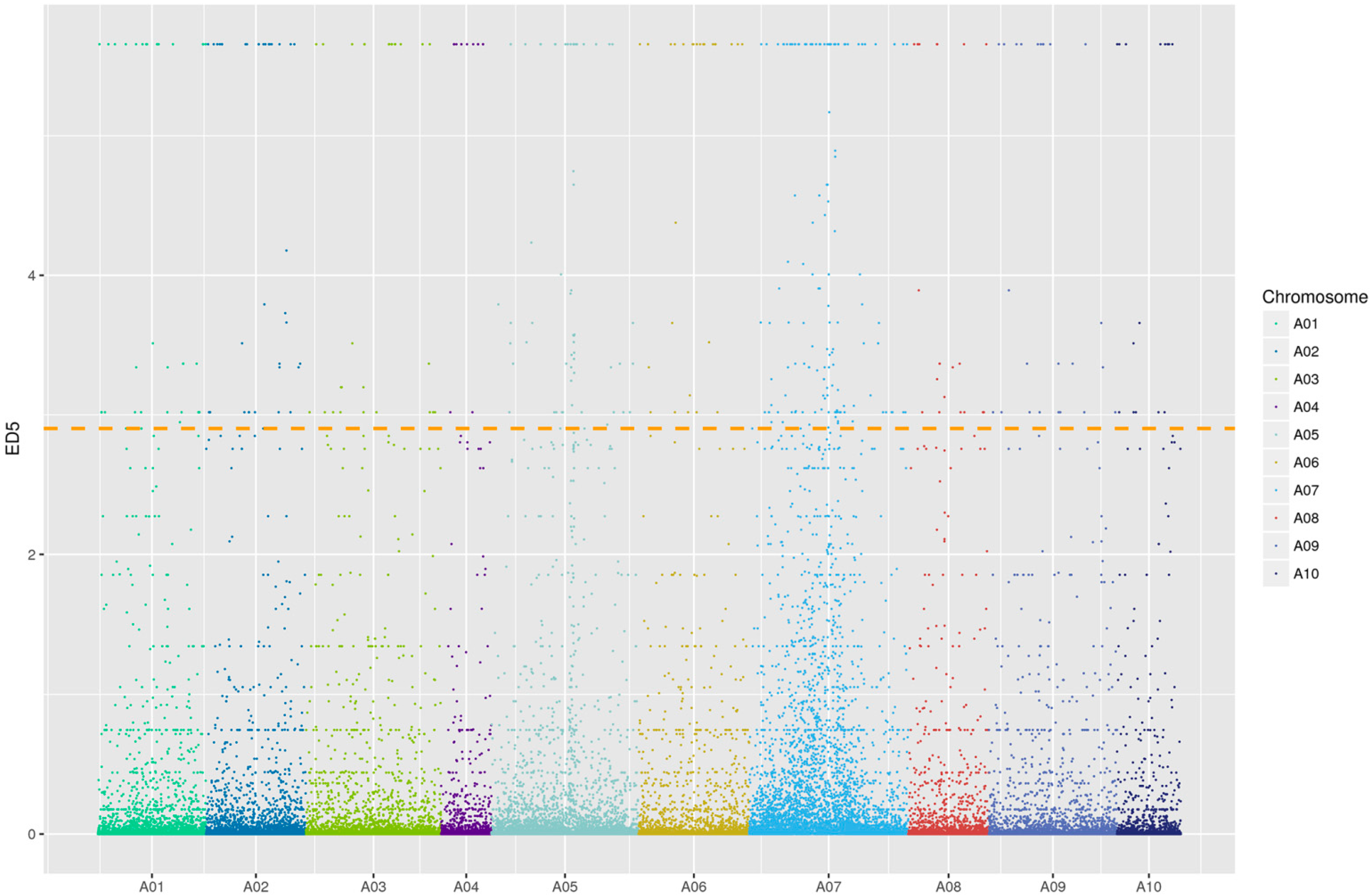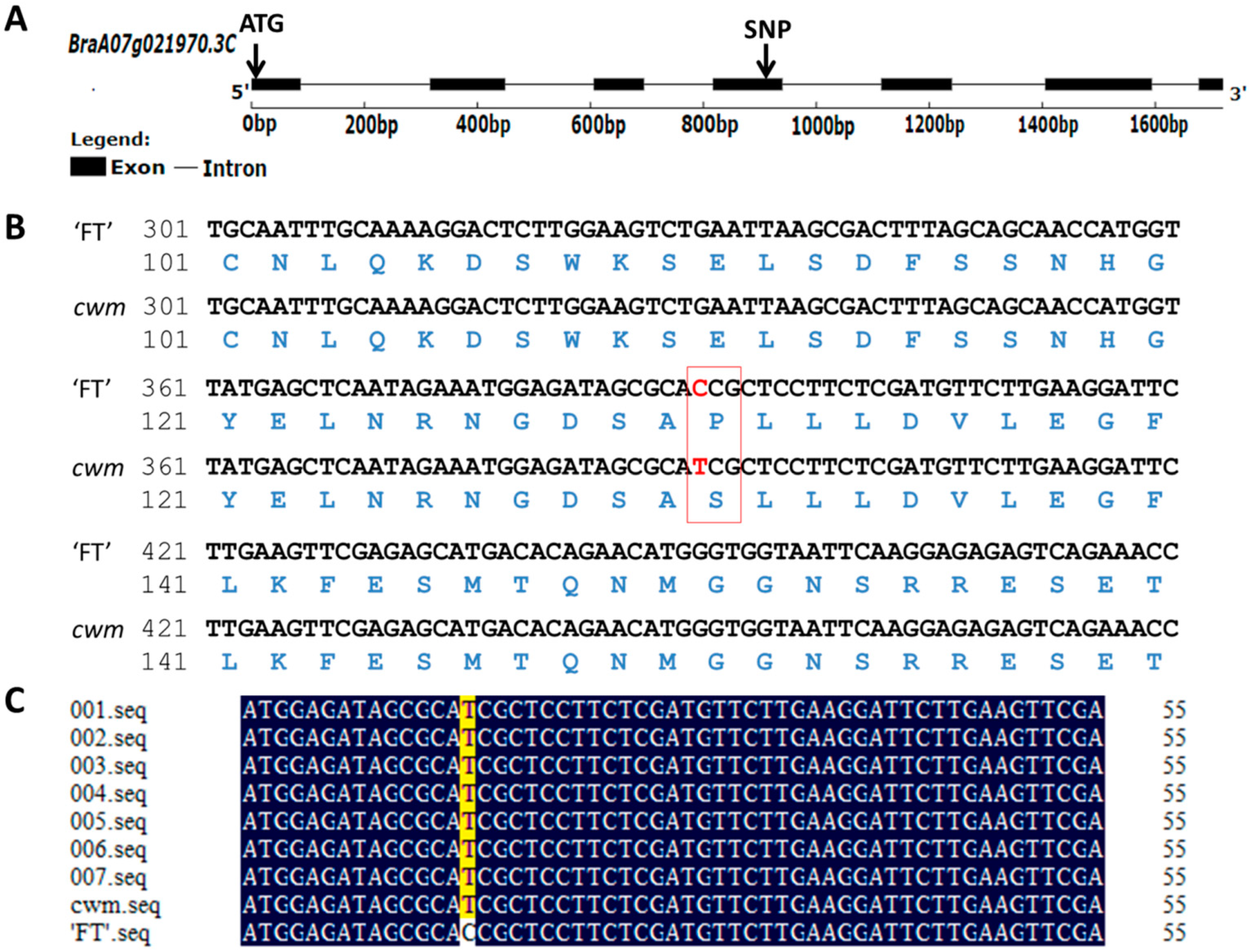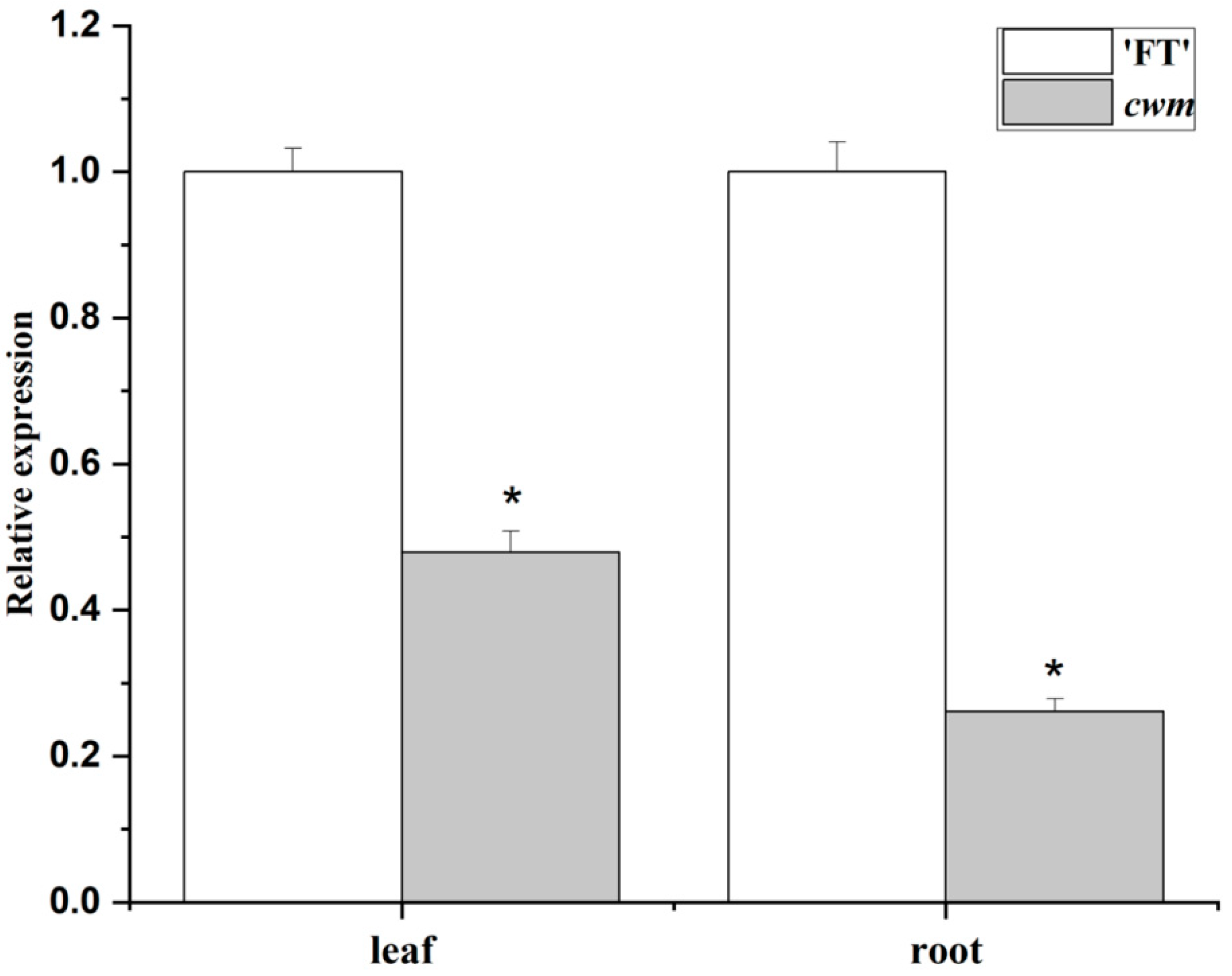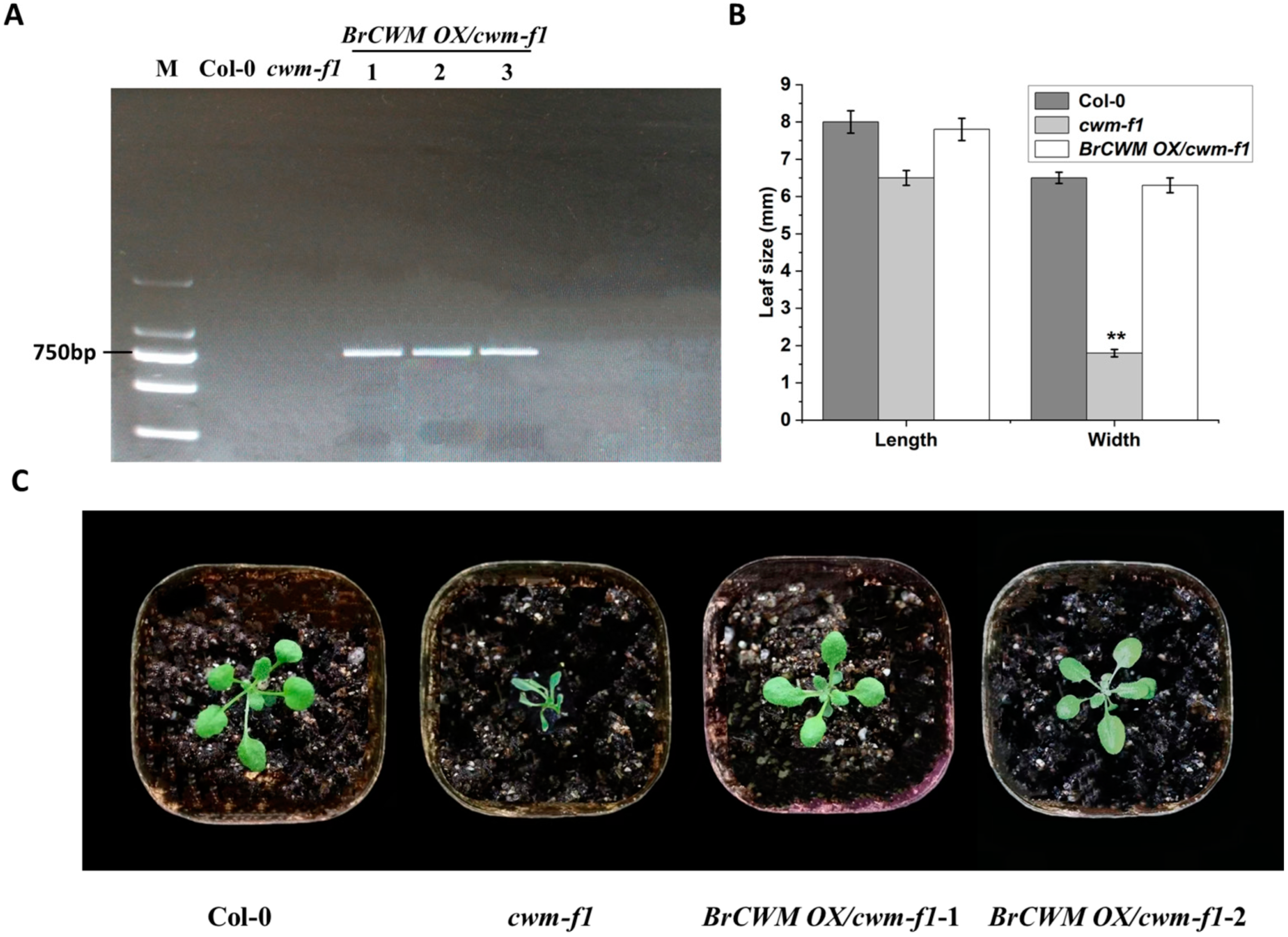BrCWM Mutation Disrupted Leaf Flattening in Chinese Cabbage (Brassica rapa L. ssp. pekinensis)
Abstract
:1. Introduction
2. Results
2.1. Morphological Characterization of the Mutant Cwm
2.2. Inheritance of the Mutated Traits
2.3. Preliminary Mapping of Brcwm Using BSR-Seq
2.4. Fine Mapping of Brcwm
2.5. Candidate Gene Screening for Cwm using Whole Genome Re-Sequencing
2.6. Clone Sequencing and Co-Segregation Analysis
2.7. Expression Analysis of BrCWM
2.8. Bioinformatic Analysis of BrCWM
2.9. Transgenic Functional Verification of BrCWM
3. Discussion
4. Materials and Methods
4.1. Plant Materials and Growth Conditions
4.2. Growth Determination
4.3. Cytological Observation
4.4. Genetic Analysis
4.5. BSR-Sequencing Analysis
4.6. DNA Extraction, Primer Design, and PCR
4.7. Whole-Genome Re-Sequencing
4.8. Clone Sequencing
4.9. Quantitative Reverse Transcriptase PCR (qRT-PCR)
4.10. Bioinformatic Analysis
4.11. Vector Construction and Arabidopsis Genetic Transformation
Supplementary Materials
Author Contributions
Funding
Data Availability Statement
Conflicts of Interest
References
- Huang, G.; Yang, Y.; Zhu, L.; Ren, X.; Peng, S.; Li, Y. The structural correlations and the physiological functions of stomatal morphology and leaf structures in C3 annual crops. Planta 2022, 256, 39. [Google Scholar] [CrossRef]
- Liu, Q.; Huang, Z.; Wang, Z.; Chen, Y.; Wen, Z.; Liu, B.; Tigabu, M. Responses of leaf morphology, NSCs contents and C:N:P stoichiometry of Cunninghamia lanceolata and Schima superba to shading. BMC Plant Biol. 2020, 20, 354. [Google Scholar] [CrossRef] [PubMed]
- Lee, S.-M.; Song, H.; Yi, H.; Hur, Y. Transcriptomic analysis of contrasting inbred lines and F2 segregant of Chinese cabbage provides valuable information on leaf morphology. Genes Genom. 2019, 41, 811–829. [Google Scholar] [CrossRef] [PubMed]
- Huang, C.; Yang, M.; Shao, D.; Wang, Y.; Wan, S.; He, J.; Meng, Z.; Guan, R. Fine mapping of the BnUC2 locus related to leaf up-curling and plant semi-dwarfing in Brassica napus. BMC Genom. 2020, 21, 530. [Google Scholar] [CrossRef]
- Rong, F.; Chen, F.; Huang, L.; Zhang, J.; Zhang, C.; Hou, D.; Cheng, Z.; Weng, Y.; Chen, P.; Li, Y. A mutation in class III homeodomain-leucine zipper (HD-ZIP III) transcription factor results in curly leaf (cul) in cucumber (Cucumis sativus L.). Theor. Appl. Genet. 2019, 132, 113–123. [Google Scholar] [CrossRef] [PubMed]
- Gong, X.; Wang, F.; Chen, H.; Liu, X.; Zhang, S.; Zhao, J.; Yi, J. Genetic Mapping and Transcriptomic Analysis Revealed the Molecular Mechanism Underlying Leaf-Rolling and a Candidate Protein Phosphatase Gene for the Rolled Leaf-Dominant (RL-D) Mutant in Rice. Plant Mol. Biol. Report. 2022, 40, 256–270. [Google Scholar] [CrossRef]
- Adedze, Y.M.N.; Feng, B.; Shi, L.; Sheng, Z.; Tang, S.; Wei, X.; Hu, P. Further insight into the role of KAN1, a member of KANADI transcription factor family in rice. Plant Growth Regul. 2018, 84, 237–248. [Google Scholar] [CrossRef]
- de Keijzer, J.; Mulder, B.M.; Janson, M.E. Microtubule networks for plant cell division. Syst. Synth. Biol. 2014, 8, 187–194. [Google Scholar] [CrossRef] [Green Version]
- Jain, K.; Yadav, S.A.; Athale, C.A. Number Dependence of Microtubule Collective Transport by Kinesin and Dynein. J. Indian Inst. Sci. 2021, 101, 19–30. [Google Scholar] [CrossRef]
- Schwarzerová, K.; García-González, J. Cortical Region of Diffusively Growing Cells as a Site of Actin–Microtubule Cooperation in Cell Wall Synthesis. In The Cytoskeleton: Diverse Roles in a Plant’s Life; Sahi, V.P., Baluška, F., Eds.; Springer International Publishing: Cham, Switzerland, 2019; pp. 1–21. [Google Scholar]
- Dhonukshe, P.; Mathur, J.; Hülskamp, M.; Gadella, T.W.J. Microtubule plus-ends reveal essential links between intracellular polarization and localized modulation of endocytosis during division-plane establishment in plant cells. BMC Biol. 2005, 3, 11. [Google Scholar] [CrossRef] [Green Version]
- Hush, J.M.; Overall, R.L. Re-orientation of cortical F-actin is not necessary for wound-induced microtubule re-orientation and cell polarity establishment. Protoplasma 1992, 169, 97–106. [Google Scholar] [CrossRef]
- Zhang, L.; Ambrose, C. CLASP balances two competing cell division plane cues during leaf development. Nat. Plants 2022, 8, 682–693. [Google Scholar] [CrossRef] [PubMed]
- Müller, S.; Han, S.; Smith, L.G. Two Kinesins Are Involved in the Spatial Control of Cytokinesis in Arabidopsis thaliana. Curr. Biol. 2006, 16, 888–894. [Google Scholar] [CrossRef] [Green Version]
- Zhang, Y.; Iakovidis, M.; Costa, S. Control of patterns of symmetric cell division in the epidermal and cortical tissues of the Arabidopsis root. Development 2016, 143, 978–982. [Google Scholar] [CrossRef] [PubMed] [Green Version]
- Spinner, L.; Pastuglia, M.; Belcram, K.; Pegoraro, M.; Goussot, M.; Bouchez, D.; Schaefer, D.G. The function of TONNEAU1 in moss reveals ancient mechanisms of division plane specification and cell elongation in land plants. Development 2010, 137, 2733–2742. [Google Scholar] [CrossRef] [Green Version]
- Whittington, A.T.; Vugrek, O.; Wei, K.J.; Hasenbein, N.G.; Sugimoto, K.; Rashbrooke, M.C.; Wasteneys, G.O. MOR1 is essential for organizing cortical microtubules in plants. Nature 2001, 411, 610–613. [Google Scholar] [CrossRef] [PubMed]
- Azimzadeh, J.; Nacry, P.; Christodoulidou, A.; Drevensek, S.P.; Camilleri, C.; Amiour, N.; Parcy, F.O.; Pastuglia, M.; Bouchez, D. Arabidopsis TONNEAU1 Proteins Are Essential for Preprophase Band Formation and Interact with Centrin. Plant Cell 2008, 20, 2146–2159. [Google Scholar] [CrossRef] [Green Version]
- Sarieva, G.E.; Kenzhebaeva, S.S.; Lichtenthaler, H.K. Adaptation potential of photosynthesis in wheat cultivars with a capability of leaf rolling under high temperature conditions. Russ. J. Plant Physiol. 2010, 57, 28–36. [Google Scholar] [CrossRef]
- Chang, L.; Mei, G.; Hu, Y.; Deng, J.; Zhang, T. LMI1-like and KNOX1 genes coordinately regulate plant leaf development in dicotyledons. Plant Mol. Biol. 2019, 99, 449–460. [Google Scholar] [CrossRef] [Green Version]
- Nidhi, S.; Preciado, J.; Tie, L. Knox homologs shoot meristemless (STM) and KNAT6 are epistatic to CLAVATA3 (CLV3) during shoot meristem development in Arabidopsis thaliana. Mol. Biol. Rep. 2021, 48, 6291–6302. [Google Scholar] [CrossRef]
- Qu, C.; Bian, X.; Han, R.; Jiang, J.; Yu, Q.; Liu, G. Expression of BpPIN is associated with IAA levels and the formation of lobed leaves in Betula pendula ‘Dalecartica’. J. For. Res. 2020, 31, 87–97. [Google Scholar] [CrossRef]
- Li, Y.-Y.; Shen, A.; Xiong, W.; Sun, Q.-L.; Luo, Q.; Song, T.; Li, Z.-L.; Luan, W.-J. Overexpression of OsHox32 Results in Pleiotropic Effects on Plant Type Architecture and Leaf Development in Rice. Rice 2016, 9, 46. [Google Scholar] [CrossRef] [PubMed] [Green Version]
- Kerstetter, R.A.; Bollman, K.; Taylor, R.A.; Bomblies, K.; Poethig, R.S. KANADI regulates organ polarity in Arabidopsis. Nature 2001, 411, 706–709. [Google Scholar] [CrossRef] [PubMed]
- Burian, A.; Paszkiewicz, G.; Nguyen, K.T.; Meda, S.; Raczyńska-Szajgin, M.; Timmermans, M.C.P. Specification of leaf dorsiventrality via a prepatterned binary readout of a uniform auxin input. Nat. Plants 2022, 8, 269–280. [Google Scholar] [CrossRef]
- Zhang, T.; Li, C.; Li, D.; Liu, Y.; Yang, X. Roles of YABBY transcription factors in the modulation of morphogenesis, development, and phytohormone and stress responses in plants. J. Plant Res. 2020, 133, 751–763. [Google Scholar] [CrossRef] [PubMed]
- Lu, Y.; Meng, Y.; Zeng, J.; Luo, Y.; Feng, Z.; Bian, L.; Gao, S. Coordination between GROWTH-REGULATING FACTOR1 and GRF-INTERACTING FACTOR1 plays a key role in regulating leaf growth in rice. BMC Plant Biol. 2020, 20, 200. [Google Scholar] [CrossRef]
- Tvorogova, V.E.; Krasnoperova, E.Y.; Potsenkovskaia, E.A.; Kudriashov, A.A.; Dodueva, I.E.; Lutova, L.A. What Does the WOX Say? Review of Regulators, Targets, Partners. Mol. Biol. 2021, 55, 311–337. [Google Scholar] [CrossRef]
- Woo, Y.-M.; Park, H.-J.; Su’udi, M.; Yang, J.-I.; Park, J.-J.; Back, K.; Park, Y.-M.; An, G. Constitutively wilted 1, a member of the rice YUCCA gene family, is required for maintaining water homeostasis and an appropriate root to shoot ratio. Plant Mol. Biol. 2007, 65, 125–136. [Google Scholar] [CrossRef]
- Hu, J.; Zhu, L.; Zeng, D.; Gao, Z.; Guo, L.; Fang, Y.; Zhang, G.; Dong, G.; Yan, M.; Liu, J.; et al. Identification and characterization of NARROW ANDROLLED LEAF 1, a novel gene regulating leaf morphology and plant architecture in rice. Plant Mol. Biol. 2010, 73, 283–292. [Google Scholar] [CrossRef]
- Yang, S.-Q.; Li, W.-Q.; Miao, H.; Gan, P.-F.; Qiao, L.; Chang, Y.-L.; Shi, C.-H.; Chen, K.-M. REL2, A Gene Encoding An Unknown Function Protein which Contains DUF630 and DUF632 Domains Controls Leaf Rolling in Rice. Rice 2016, 9, 37. [Google Scholar] [CrossRef] [Green Version]
- Ping, X.; Ye, Q.; Yan, M.; Zeng, J.; Yan, X.; Li, H.; Li, J.; Liu, L. Integrated genetic mapping and transcriptome analysis reveal the BnaA03. IAA7 protein regulates plant architecture and gibberellin signaling in Brassica napus L. Theor. Appl. Genet. 2022, 135, 3497–3510. [Google Scholar] [CrossRef] [PubMed]
- Baskin, T.I. On the alignment of cellulose microfibrils by cortical microtubules: A review and a model. Protoplasma 2001, 215, 150–171. [Google Scholar] [CrossRef] [PubMed]
- Oda, Y. Emerging roles of cortical microtubule–membrane interactions. J. Plant Res. 2018, 131, 5–14. [Google Scholar] [CrossRef]
- Drevensek, S.; Goussot, M.; Duroc, Y.; Christodoulidou, A.; Steyaert, S.; Schaefer, E.; Duvernois, E.; Grandjean, O.; Vantard, M.; Bouchez, D.; et al. The Arabidopsis TRM1–TON1 Interaction Reveals a Recruitment Network Common to Plant Cortical Microtubule Arrays and Eukaryotic Centrosomes. Plant Cell 2012, 24, 178–191. [Google Scholar] [CrossRef] [PubMed] [Green Version]
- Zhao, F.; Du, F.; Oliveri, H.; Zhou, L.; Ali, O.; Chen, W.; Feng, S.; Wang, Q.; Lü, S.; Long, M.; et al. Microtubule-Mediated Wall Anisotropy Contributes to Leaf Blade Flattening. Curr. Biol. 2020, 30, 3972–3985. [Google Scholar] [CrossRef] [PubMed]
- Alamin, M.; Zeng, D.-D.; Sultana, M.H.; Qin, R.; Jin, X.-L.; Shi, C.-H. Photosynthesis, cellulose contents and ultrastructure changes of mutant rice leading to screw flag leaf. Plant Growth Regul. 2018, 85, 1–13. [Google Scholar] [CrossRef]
- Navarro, J.M.; Garrido, C.; Martínez, V.; Carvajal, M. Water relations and xylem transport of nutrients in pepper plants grown under two different salts stress regimes. Plant Growth Regul. 2003, 41, 237–245. [Google Scholar] [CrossRef]
- Schubert, M.; Lindgreen, S.; Orlando, L. AdapterRemoval v2: Rapid adapter trimming, identification, and read merging. BMC Res. Notes 2016, 9, 88. [Google Scholar] [CrossRef] [Green Version]
- Zhu, P.; He, L.; Li, Y.; Huang, W.; Xi, F.; Lin, L.; Zhi, Q.; Zhang, W.; Tang, Y.T.; Geng, C.; et al. OTG-snpcaller: An optimized pipeline based on TMAP and GATK for SNP calling from ion torrent data. PLoS ONE 2014, 9, e97507. [Google Scholar] [CrossRef] [Green Version]
- Wang, K.; Li, M.; Hakonarson, H. ANNOVAR: Functional annotation of genetic variants from high-throughput sequencing data. Nucleic Acids Res. 2010, 38, e164. [Google Scholar] [CrossRef]
- Zhao, Y.; Huang, S.; Zhang, M.; Zhang, Y.; Feng, H. Mapping of a Pale Green Mutant Gene and Its Functional Verification by Allelic Mutations in Chinese Cabbage (Brassica rapa L. ssp. pekinensis). Front. Plant Sci. 2021, 12, 699308. [Google Scholar] [CrossRef] [PubMed]
- Engler, C.; Kandzia, R.; Marillonnet, S. A one pot, one step, precision cloning method with high throughput capability. PLoS ONE 2008, 3, e3647. [Google Scholar] [CrossRef] [PubMed] [Green Version]









| Generation | Normal Leaves | Wrinkled Leaves | Segregation Ratio | Expected Ratio | χ2 |
|---|---|---|---|---|---|
| P1 (FT) | 50 | 0 | |||
| P2 (cwm) | 0 | 50 | |||
| P1 × P2 | 35 | 0 | |||
| P2 × P1 | 35 | 0 | |||
| (P1 × P2) × P1 | 40 | 0 | |||
| (P1 × P2) × P2 | 19 | 21 | 1.167:1 | 1:1 | 0.100 |
| F2 | 184 | 66 | 2.787:1 | 3:1 | 0.192 |
| Sample | Total Raw Reads | Total Clean Reads | Total Mapping | Total Mapping Ratio | Q30 (%) | GC Content (%) |
|---|---|---|---|---|---|---|
| ‘FT’ | 39,548,850 | 39,346,988 | 31,994,128 | 0.81 | 95.23 | 48.22 |
| cwm | 41,723,712 | 41,518,202 | 33,960,896 | 0.81 | 95.23 | 48.30 |
| Chromosome | Start Site | End Site | SNV Count | Target Length |
|---|---|---|---|---|
| A05 | 24,538,973 | 26,614,010 | 25 | 2,075,037 |
| A07 | 10,076,460 | 11,983,310 | 20 | 1,906,850 |
| A07 | 13,806,342 | 15,548,454 | 28 | 1,742,112 |
| A07 | 17,469,944 | 20,228,803 | 57 | 2,758,859 |
Disclaimer/Publisher’s Note: The statements, opinions and data contained in all publications are solely those of the individual author(s) and contributor(s) and not of MDPI and/or the editor(s). MDPI and/or the editor(s) disclaim responsibility for any injury to people or property resulting from any ideas, methods, instructions or products referred to in the content. |
© 2023 by the authors. Licensee MDPI, Basel, Switzerland. This article is an open access article distributed under the terms and conditions of the Creative Commons Attribution (CC BY) license (https://creativecommons.org/licenses/by/4.0/).
Share and Cite
Wu, Y.; Xin, Y.; Zou, J.; Huang, S.; Wang, C.; Feng, H. BrCWM Mutation Disrupted Leaf Flattening in Chinese Cabbage (Brassica rapa L. ssp. pekinensis). Int. J. Mol. Sci. 2023, 24, 5225. https://doi.org/10.3390/ijms24065225
Wu Y, Xin Y, Zou J, Huang S, Wang C, Feng H. BrCWM Mutation Disrupted Leaf Flattening in Chinese Cabbage (Brassica rapa L. ssp. pekinensis). International Journal of Molecular Sciences. 2023; 24(6):5225. https://doi.org/10.3390/ijms24065225
Chicago/Turabian StyleWu, Yanji, Yue Xin, Jiaqi Zou, Shengnan Huang, Che Wang, and Hui Feng. 2023. "BrCWM Mutation Disrupted Leaf Flattening in Chinese Cabbage (Brassica rapa L. ssp. pekinensis)" International Journal of Molecular Sciences 24, no. 6: 5225. https://doi.org/10.3390/ijms24065225





